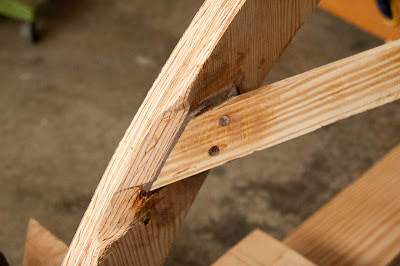With southern yellow pine prices locally being 1/5 the cost of mahogany, it seemed like a good choice. I just can't afford to be breaking 12' pieces of mahogany. (If you can, go for it. I think most would agree that mahogany is a superior boatbuilding wood). White oak is another good substitute, but there again, the southern yellow pine is substantially more affordable locally. Not only that, but Glen L Witt's Boatbuilding With Plywood has some good things to say about southern yellow pine, including the statement that it's frequently substituted for white oak.
For my part, I'm glad I chose southern yellow pine. The wood bends very easily. I got started on the chines in late January 2013.
February suddenly found me lying in a hospital bed, waiting on an open slot for heart surgery. Not a pleasant position to be in. Since my doctors considered my case too high-risk to even let me walk the hallways before surgery, I occupied my time with Howard I. Chapelle's Boatbuilding: A Complete Handbook of Wooden Boat Construction, John Gardner's The Dory Book, and the latest issue of Wooden Boat Magazine. (When I said I was hooked on boatbuilding, I meant it.) Many of the fine medical staff who were looking after me were curious about my boatbuilding books & interest.
Before, during, and after the surgery, I was blessed with an outpouring of support from my family and friends, a multitude of prayers, visits from my church priest, and a visiting priest on Ash Wednesday. I tell you, it is an amazing and very humbling experience to be on the receiving end of the power of prayer. To witness its effects firsthand is simply dumbfounding. I have been blessed with a speedy recovery. I was able to walk unassisted the day after my surgery.
By March, while recovering at home, I was back to work on the chines. Basically, this involves:
1. Beveling the notch in the forward frame;
2. Bending and clamping the chine log into position;
3. Cutting the bevel at the forward end of the chine;
4. Fitting the aft end of the chine to the transom;
5. Fastening the chine into place with marine epoxy and bronze screws.
 |
| Chine logs roughly bent into their general position. |
 |
| Initial bevel cut on forward end of chines. |
I broke one of the chine logs while clamping it into its fully-bent position. While southern yellow pine indeed bends very easily, it does have its breaking point (literally). Most chine breaks occur near the forward frame, where the bend in the wood is greatest. I ripped another 2" x 12' piece with a handsaw and clamped it into place. Before bending it fully, I soaked the wood with hot water-soaked towels wrapped around it. I also applied as much steam as I could, using my steam iron.
Once the chine logs are bent into place, you cut the bevel at the forward end of the chine, using the vertical side surface of the stem as a guide. This gives a good approximation of the final bevel, but it needs to be cut again after the chine log is moved backward into its final position. Moving the chine backward changes the angle of the bend from the forward frame to the nearer end-point. The chine log is moved backward some because the forward tip of the chine is fitted a few inches short of the forward edge of the stem. This is so that the forward edge of the stem can be beveled so that the line of the chine curve continues forward to a sharp point on the bow. I had to make several additional cuts to the forward chine bevel in order to get the best fit. I used a 1/4" plywood spacer as a guide for my back saw, and this proved to be quite effective.
 |
| This is the gap that is created after repositioning the chine rearwards. This gap makes it necessary to re-cut the bevel. |
 |
| Using a piece of 1/4" plywood as a guide helped greatly in getting the bevel cut correctly. |
The aft end of the chine log is cut and fit after the forward end. Fitting the chine to the transom is very similar to fitting the floor battens. A little beveling with a rasp and file will do the job.
Once the chine logs are cut and fit to their final shape and position, they are fastened into place with thickened marine epoxy and bronze screws. I followed Glen-L's recommendation to only use epoxy (not screws) at the junction of the chine to the forward frame notch. This is to avoid weakening the chine log at the point where it is most likely to break. Another technique I'd recommend is to temporarily clamp a guide into place on the side of the stem. This guide will serve as a "ledge" on which to rest the forward end of the chine when you bend it back into position for final fastening. It will help with alignment of the chine to any holes you may have already drilled through it and into the stem. These can be rather tricky to find with thickened epoxy slopped all over the place.
 |
| Forward end of chine attached to stem. Epoxy was thickened with mahogany wood flour. |
 |
| Chine-to-forward-frame connection. |
 |
| Chine-to-forward-frame connection. |
 |
| Chine-to-frame-1 connection. |
 |
| Chine-to-transom connection. |
 |
| Chine-to-stem connection after sanding & initial fairing. |
 |
| Chine-to-transom connection after sanding & initial fairing. |

No comments:
Post a Comment